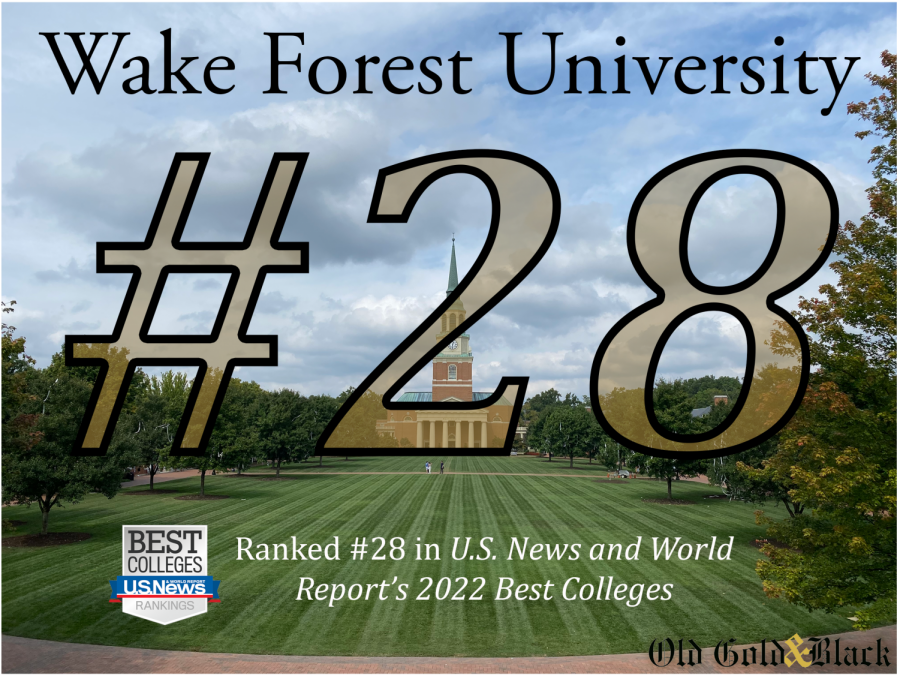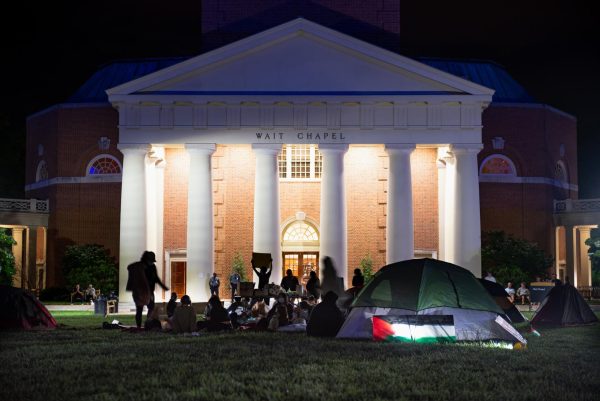U.S. News ranks Wake Forest 28th once again
U.S. News ranks Wake Forest 28th once again
September 23, 2021
These days, the phrase “admissions is a numbers game” can be interpreted in more than one way.
On Sept. 13, U.S. News & World Report released its list of 2022 U.S. News Best National Universities. This year, 1,466 bachelor’s degree-granting schools and national universities were evaluated, and only 392 made the list. Wake Forest University was one of them, sitting at No. 28.
Wake Forest has been in the top-30 of the U.S. Best National Universities report for the past 26 years. But, in a less-than-typical outcome Wake Forest shares that No. 28 slot with five other universities: New York University, Tufts University, University of California Santa Barbara, University of Florida and University of North Carolina Chapel Hill.
According to the U.S. News website, a reporting and research team uses 17 unique measures of “academic quality” to assess and rank four-year institutions. These assessment tools are as follows: Alumni giving rate average, class size, average faculty salaries, percentage of full-time professors or faculty members with a doctoral degree, financial aid resources available, expert opinions — as measured via peer assessments completed by a university’s faculty members — first-year student retention rate, alumni indebtedness, graduation rate, average students’ high school rankings, Pell Grant graduation rates, performance of Pell Grant recipients, student-to-faculty ratio, standardized test scores and the number of full-time faculty members.
Each of these factors is weighted differently. For example, according to the U.S. News and World Report website, the typical six-year graduation rate is weighted at 17.6% while the Pell Grant graduation rate is weighted at 2.5%.
This difference in weight is meant to level the playing field between schools. Even still, not all students see this as an effective way to ensure equity among institutions.
What do these rankings mean for admissions and current students? Are the slots on the ranking list arbitrary numbers, or do prospective students care about rankings?
So, perhaps more importantly: Will the upcoming Wake Forest admissions cycle be impacted by the school’s place in the national rankings?
Unfortunately, Vice President of Enrollment Eric Maguire does not have the magic answers to these questions. Nor do President and Vice President of Ambassadors in Admissions Jessie Birnbaum and Emma Galante.
But there is one agreement that Maguire, Birnbaum and Galante can agree on — specific number rankings do not matter just so long as the school is near the top.
“It matters more the range of where we are,” Galante said. “We are top-30, not No. 28 in my eyes. I don’t think 27 versus 28 versus 29 matters at all. On my tours, I mention that we are a top-30 school and move on.”
Birnbaum does not even mention Wake Forest’s ranking on her tours.
“I personally don’t talk about the rankings because I think, if you’re touring Wake Forest, you already know what they are,” she said. “Typically, people who are looking at Wake Forest are looking at top schools.”
Birnbaum then compared her own college search to the application journey for prospective students today.
“I would love to say that I didn’t care about rankings when I was looking for colleges,” Birnbaum said, laughing. “I didn’t care about the exact ranking — if it was top-30 or a little below — but I wanted to go to a school where I knew there would be good academics and I would be surrounded by students who also cared about that.”
Freshman Riley Shanaghan recalls not individually caring about Wake Forest’s national ranking. For her, it was more important to go to a school that offered her a competitive scholarship than it was to go to an elite school.
“It all came down to money in the end,” Shanaghan said. “I feel like Wake Forest is ranked pretty high but not high enough for people to consider it an ‘elite school’. Not a lot of people from the other side of the country really know about Wake Forest.”
Time has impacted the ways both undergraduate universities and individual, prospective students view the admissions process. According to the Wake Forest Fact Book, approximately 9,869 students applied to Wake Forest in 2011, 3,933 were admitted and 1,237 enrolled. Then, nine years later, nearly 12,000 prospective students applied and only 3,825 students were admitted.
For context, Wake Forest ranked 25th nation-wide in 2011. In 2020, Wake Forest dropped and hovered around 30th. Yet, the school’s acceptance rate fell from 39.8% to 31%.
So, perhaps national ranking lists do not have the power that high school counselors think they do. Or, as Galante phrased it, “perhaps a number truly is only a number.”























